Saltire Games Family & Hobby Game Store Events

A diagonal cross (decussate cross, saltire, St. Andrew's Cantankerous)
A saltire, as well called Saint Andrew's Cross or the crux decussata,[i] is a heraldic symbol in the form of a diagonal cross, like the shape of the letter X in Roman blazon. The give-and-take comes from the Middle French sautoir, Medieval Latin saltatoria ("stirrup").[two]
From its employ equally field sign, the saltire came to exist used in a number of flags, in the 16th century for Scotland and Burgundy, in the 18th century likewise as the ensign of the Russian Navy, and for Republic of ireland. Notable 19th-century usage includes some of the flags of the Confederate States of America. Information technology is also used in the flag of Jamaica and on seals, and as a heraldic charge in coats of arms.
The term saltirewise or in saltire refers to heraldic charges arranged as a diagonal cross. The shield may also be divided per saltire, i.e. diagonally.
A alert sign in the shape of a saltire is also used to point the signal at which a railway line intersects a route at a level crossing.
Heraldry and vexillology [edit]
The saltire is important both in heraldry, existence establish in many coats of arms, and in vexillology, beingness institute as the ascendant feature of multiple flags.

Glaze of artillery of the counts of Ötingen (Oettingen): Azure a bordure vair ancien gules and or, a saltire argent over all (attested from equally early as 1180,[3] here in the delineation in the Zürich armorial, c. 1340).
The saltire is one of the so-called ordinaries, geometric charges that span throughout (from edge to edge of) the shield. Equally suggested by the name saltire ("stirrup"; in French: sautoir, in German: Schragen), the ordinary in its early on use was non intended every bit representing a Christian cross symbol. The association with Saint Andrew is a evolution of the 15th to 16th centuries. The Cantankerous of Burgundy emblem originates in the 15th century, as a field sign, and every bit the Saint Andrew'due south Cantankerous of Scotland was used in flags or banners (but not in coats of arms) from the 16th century, and used as naval ensign during the Age of Sail.
When two or more saltires appear, they are ordinarily blazoned as couped (cut off). For instance, contrast the single saltire in the arms granted to Grand. Thousand. W. Anderson[a]—with the three saltires couped in the coat of Kemble Greenwood.[b]
Atomic forms include the fillet saltire,[c] usually considered half or less the width of the saltire, and the saltorel, a narrow or couped saltire.
A field (party) per saltire is divided into four areas by a saltire-shaped "cut". If two tinctures are specified, the starting time refers to the areas in a higher place (in chief) and beneath (in base) the crossing, and the second refers to the ones on either side (in the flanks).[d] Otherwise, each of the four divisions may be blazoned separately.
The phrase in saltire or saltirewise is used in two ways:
- 2 long narrow charges "in saltire" are placed to cross each other diagonally. Common forms include the crossed keys constitute in the arms of many entities associated with Saint Peter and paired arrows.[e]
- When five or more meaty charges are "in saltire", they are arranged with one in the center and the others along the artillery of an invisible saltire.[f] [g]
Division of the field per saltire was notably used by the Aragonese kings of Sicily beginning in the 14th century (Frederick the Simple), showing the pales of Aragon and the "Hohenstaufen" eagle (argent an eagle sable).
Scotland [edit]
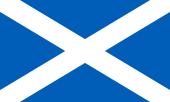
The Flag of Scotland, chosen The Saltire or Saint Andrew's Cross, is a blue field with a white saltire. According to tradition, information technology represents Saint Andrew, who is supposed to take been crucified on a cross of that form (chosen a crux decussata) at Patras, Greece.
The Saint Andrew'due south Cross was worn as a badge on hats in Scotland, on the twenty-four hours of the feast of Saint Andrew.[1]
In the politics of Scotland, both the Scottish National Party and Scottish Conservative Party use stylised saltires as their party logos, deriving from the flag of Scotland.
Prior to the Union the Regal Scots Navy used a ruby-red ensign incorporating the St Andrew's Cross; this ensign is now sometimes flown as part of an unofficial ceremonious ensign in Scottish waters. With its colours exchanged (and a lighter blue), the same design forms part of the arms and flag of Nova Scotia (whose name means "New Scotland").
Cross of Burgundy [edit]

The Cross of Burgundy, a course of the Saint Andrew'southward Cantankerous, is used in numerous flags across Europe and the Americas. It was first used in the 15th century as an emblem by the Valois Dukes of Burgundy. The Duchy of Burgundy, forming a big part of eastern France and the Low Countries, was inherited by the Firm of Habsburg on the extinction of the Valois ducal line. The keepsake was therefore assumed by the monarchs of Spain as a consequence of the Habsburgs bringing together, in the early on 16th century, their Burgundian inheritance with the other extensive possessions they inherited throughout Europe and the Americas, including the crowns of Castile and Aragon. Every bit a result, the Cross of Burgundy has appeared in a broad variety of flags connected with territories formerly office of the Burgundian or Habsburg inheritance. Examples of such multifariousness include the Spanish naval ensign (1506-1701), the flag of Carlism (a nineteenth century Spanish conservative movement), the flag of the Dutch uppercase of Amsterdam and municipality of Eijsden, the flag of Chuquisaca in Republic of bolivia and the flags of the United states of america states of Florida and Alabama.
Gascony [edit]

Gascony has not had whatever institutional unity since the 11th century, hence several flags are currently used in the territory. Legend says that this flag appeared in the time of Pope Clement III to gather the Gascons during the Third Cause (12th century). That flag, sometimes called "Union Gascona" (Gascon Wedlock), contains the St Andrew's cantankerous, the patron saint of Bordeaux and the red color of English kingdom, which reigned over Gascony from 12th to mid-15th century.
In Tome xiv of the Grande Encyclopédie, published in France between 1886 and 1902 by Henri Lamirault, it says
during the hard times of the Hundred Years' State of war and the terrible struggles between the Armagnacs, representing the national political party (white cross) and the Burgundians, allied to the English (blood-red cross and reddish Saint Andrew'south cross), the flag of the victorious English language ends up gathering, in 1422, under Henri VI, on its field the white and red crosses of France and England, the white and red Saint Andrew's crosses of Guyenne and Burgundy.[10]
That saltire is as well represented in the pattern of some talenquères in many bullrings in Gascony.[eleven]
Maritime flags [edit]

The naval ensign of the Imperial Russian (1696–1917) and Russian navies (1991–present) is a blue saltire on a white field.
The international maritime signal flag for Thousand is a white saltire on a blue background, and indicates a stopped vessel. A red saltire on a white background denotes the letter of the alphabet V and the message "I require assistance".
Others [edit]
The flags of the Colombian archipelago of San Andrés and Providencia and the Spanish isle of Tenerife likewise use a white saltire on a blueish field. The Brazilian cities of Rio de Janeiro and Fortaleza also utilize a blueish saltire on a white field, with their coats-of-arms at the hub.
Saltires are also seen in several other flags, including the flags of Grenada, Jamaica, Alabama, Florida, Jersey, Logroño, Vitoria, Amsterdam, Breda, Katwijk, Potchefstroom, The Bierzo and Valdivia, equally well as the onetime Indian princely states of Khairpur, Rajkot and Jaora.
The design is besides part of the Amalgamated Battle Flag and Naval Jack used during the American Civil War (run into Flags of the Confederate States of America). Arthur L. Rogers, designer of the final version of the Confederate National flag, claimed that information technology was based on the saltire of Scotland.[12] The saltire is used on modern-day Southern U.Due south. state flags to honour the quondam Confederacy.[13]
Christian symbol [edit]
Anne Roes (1937) identifies a pattern consisting of ii crossing diagonal lines in a rectangle, sometimes with four dots or balls in the iv quarters, as an emblem or vexillum (standard) of Persepolis during the third to 2nd centuries BC. Roes also finds the design in Argive vase painting, and yet earlier in button seals of the Iranian Chalcolithic. Roes too notes the occurrence of a very similar if not identical vexillum which repeatedly occurs in Gaulish coins of c. the 2nd to 1st century BC, in a recurring pattern where it is held by a charioteer in front of his human-headed equus caballus.[14] A big number of coins of this type (118 out of 152 items) forms part of the Les Sablons hoard of the 1st century BC, discovered in Le Mans between 1991 and 1997, associated with the Cenomani.[15]
The aforementioned design is found on coins of Christian Roman emperors of the 4th to 5th centuries (Constantius II, Valentinian, Jovian, Gratianus, Valens, Arcadius, Constantine Three, Jovinus, Theodosius I, Eugenius and Theodosius II). The letter Χ (Chi) was from an early time used equally a symbol for Christ (unrelated to the Christian cross symbol, which at the time was given a T-shape). The vexillum on imperial coins from the 4th century was sometimes shown equally the Labarum, surmounted by or displaying the Chi-Rho monogram rather than just the crux decussata. The emblem of the crux decussata in a rectangle, sometimes with four dots or balls, re-appears in coins the Byzantine Empire, in the 9th to 10th centuries. Roes suggested that early on Christians endorsed its solar symbolism every bit appropriate to Christ.[16]
-

Gold stater of the Cenomani, on the reverse an androcephalous horse led by a charioteer extending a vexillum in front of it, riding over a fallen enemy.
-

Coin of Theodosius I (393–395), with a vexillum displaying a crux decussata
-
Coin of Theodosius II (425–429), showing the emperor with globus cruciger and with the same vexillum
The clan with Saint Andrew develops in the late medieval period. The tradition according to which this saint was crucified on a decussate cross is not found in early hagiography. Depictions of Saint Andrew being crucified in this style kickoff appear in the 10th century, but do not go standard earlier the 17th century.[17] Reference to the saltire equally "St Andrew's Cross" is made past the Parliament of Scotland (where Andrew had been adopted as patron saint) in 1385, in a decree to the result that every Scottish and French soldier (fighting against the English under Richard 2) "shall have a sign earlier and backside, namely a white St. Andrew'south Cross".[18]
-
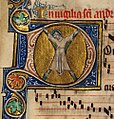
Saint Andrew martyred on a decussate cantankerous (miniature from an East Anglian missal, c. 1320)
-

Other [edit]
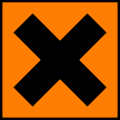
The diagonal cantankerous (decussate cross) or Ten mark is chosen "saltire" in heraldic and vexillological contexts.
A black diagonal cantankerous was used in an one-time European Spousal relationship standard as the chance symbol for irritants (Xi) or harmful chemicals (Xn). It indicated a hazard less severe than skull and crossbones, used for poisons, or the corrosive sign.
The Maria Theresa thaler has a Roman numeral ten to symbolize the 1750 debasement of the coinage, from 9 to 10 thalers to the Vienna marking (a weight of argent).
A diagonal cantankerous known every bit "crossbuck" is used as the conventional road sign used to point the point at which a railway line intersects a route at a level crossing, called a in this context. A white diagonal cross on a blueish background (or black on xanthous for temporary signs) is displayed in United kingdom of great britain and northern ireland railway signalling as a "cancelling indicator" for the Automated Warning Organization (AWS), informing the commuter that the received alert can be disregarded.
In Republic of cameroon, a red "X" placed on illegally constructed buildings scheduled for demolition is occasionally referred to as a "St Andrew'south Cantankerous". Information technology is unremarkably accompanied by the letters "A.D." ("à détruire"—French for "to be demolished") and a date or deadline. During a campaign of urban renewal by the Yaoundé Urban Council in Republic of cameroon, the cross was popularly referred to as "Tsimi'due south Cross" afterwards the Regime Consul to the council, Gilbert Tsimi Evouna.[19]
In traditional timber framing a pair of crossing braces is sometimes called a saltire or a St. Andrew's Cross.[xx] Half-timbering, particularly in French republic and Deutschland, has patterns of framing members forming many different symbols known every bit ornamental bracing.[21]
Unicode encoded various decussate crosses under the name of saltire, they are U+2613 ☓ SALTIRE (HTML☓), U+1F7A8 🞨 THIN SALTIRE (HTML🞨), U+1F7A9 🞩 Light SALTIRE (HTML🞩), U+1F7AA 🞪 MEDIUM SALTIRE (HTML🞪), U+1F7AB 🞫 Bold SALTIRE (HTML🞫), U+1F7AC 🞬 HEAVY SALTIRE (HTML🞬), U+1F7AD 🞭 VERY HEAVY SALTIRE (HTML🞭) and U+1F7AE 🞮 EXTREMELY HEAVY SALTIRE (HTML🞮).
Gallery [edit]
Coats of arms [edit]
-
Quarterly 1st & quaternary: Barry of six [seven] vair and gules; second & 3rd: Gules, a saltire vair (Henry Beaumont of Devon, d.1591)
-

Argent a saltire floretty gules (Busséol)
-
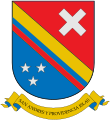
- saltirewise
-

-
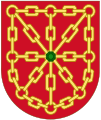
Gules a cross saltire and orle of chains linked together or, in the fess signal an emerald vert (Kingdom of Navarre)
-
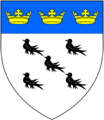
Argent five martlets saltirewise sable on a chief azure iii ducal crowns or (Bodley)
- in supporters
-

-

-
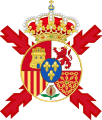
-

Coat of artillery of Barbados with Sugar Cane held saltirewise.
Flags [edit]
-

-

-

-

-

-

Tercio de la Liga (1571)
-

-

-

-

Unknown Tercio flag (appears most commander Ambrogio Spinola in the painting "The Surrender of Breda" of Diego Velázquez) (1621)
-
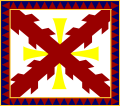
Tercio de Alburquerque (1643)
-

Tercio Morados Viejos (1670)
-
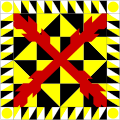
Tercio Amarillos Viejos (1680)
-

-

-

-

-

-

Flag of Shanghai Municipal Council, Shanghai International Settlement (c. 1917 – 1943)
-

-

-

-

-

-

-

-

-

-

-

-

-

-

-

Flag of the Federal Customs Service of Russia (1994)
-

-

-

-

- International Code of Signals
- U.s.a. states
Armed forces insignia [edit]
Orders [edit]
Encounter besides [edit]
- Christian cantankerous
- Cantankerous of Saint Peter
- Crossbuck
- Nordic cross
- Saint George's Cross
- Saint Patrick'south Saltire
- X mark
Notes [edit]
- ^ Or on a saltire engrailed Azure 2 quill pens in saltire Argent enfiling a Loyalist military machine coronet Or [iv]
- ^ Sable a chevron Erminois cotised between three saltires couped Or [v]
- ^ The coat of the S African National Cultural and Open-air Museum: Or; an ogress charged with a fillet saltire surmounted by an eight spoked cycle or, and ensigned of a billet sable; a chief nowy gabled, Sable
- ^ The coat of the Sandwell Metropolitan Borough Council: Per saltire Vert and Or iv Fers de Moline counterchanged in fess bespeak a Fountain. [half dozen]
- ^ Suffolk County Quango's Gules a Base barry wavy enarched Silver and Azure issuant therefrom a Sunburst in principal two Aboriginal Crowns enfiled by a pair of Arrows in saltire points downward all Or [vii]
- ^ Winchester City Council: Gules five castles triple towered, in saltire, argent, masoned proper the portcullis of each part-raised, or, and on either side of the castle in fess point a lion passant guardant that to the dexter contourny Or [8]
- ^ The arms of the Episcopal Church in the United states: Argent; a quarter azure charged with 9 cross crosslets in saltire silvery, overall a cross gules [9]
References [edit]
- ^ "Crux decussata". Merriam-Webster Dictionary. Merriam-Webster, Inc. Retrieved July 24, 2018.
- ^ Heraldic utilize 13th century (attested 1235, Huon de Méry, Tournoiemenz Antecrist, 5. 654). In 1352 also of a particular form of stirrup (Comput. Steph. de la Fontaine argent, du Cange s.v. "saltatoria"). 15th-century use in the sense of a barrier of wooden pegs arranged crosswise, preventing the passage of livestock that can still be jumped by people. "sautoire" in TLFi; see as well "saltire" at etymonline.com.
- ^ Berhard Peter, Die Wappen des Hauses Oettingen (2010–2016).
- ^ "Anderson, George Milton William [Individual]". Archive.gg.ca. 2005-07-28. Retrieved 2012-09-09 .
- ^ "Greenwood, Kemble [Individual]". Archive.gg.ca. 2005-07-28. Retrieved 2013-10-25 .
- ^ "Civic Heraldry Of England And Wales-Due west Midlands". Civicheraldry.co.great britain. Retrieved 2012-09-09 .
- ^ "Civic Heraldry Of England And Wales - East Anglia And Essex Area". Civicheraldry.co.u.k.. Archived from the original on 2009-08-28. Retrieved 2012-09-09 .
- ^ "Civic Heraldry Of England And Wales - Cornwall And Wessex Area". Civicheraldry.co.uk. Retrieved 2012-09-09 .
- ^ "Logos, Shields & Graphics".
- ^ a b La grande encyclopédie : Inventaire raisonné des sciences, des lettres et des arts. Tome 14 / Par une société de savants et de gens de lettres ; sous la dir. De MM. Berthelot,... Hartwig Derenbourg,... F.-Camille Dreyfus,... A. Giry,... [et al.].
- ^ @Pickwicq (21 February 2016). "Amandine derrière la talenquère pour pentecôte à Samadet 2015" (Tweet) – via Twitter.
- ^ Coski, John One thousand. (2005). The Amalgamated Battle Flag: America's Most Embattled Keepsake. United states of america of America: First Harvard University Press. pp. 17–xviii. ISBN978-0-674-01722-one.
- ^ Coski, John M. (2005). The Confederate Battle Flag: America's Most Embattled Keepsake. United states of america of America: Offset Harvard Academy Press. p. 79. ISBN978-0-674-01722-1.
- ^ Roes (1937), footnote 15, citing Henri de La Tour, Atlas de monnaies gauloises (1892), plates xxi, xxiii, coins of the Aulerci Diablintes, Aulerci Cenomani and Osismii.
- ^ Trésors monétaires, volume XXIV, BNF, 2011.
- ^ Anne Roes, "An Iranian standard used as a Christian symbol", The Journal of Hellenic Studies, 57.2 (1937), pp. 248–51
- ^ Cudith Calvert, "The Iconography of the St. Andrew Auckland Cross", The Art Bulletin 66.4 (Dec 1984:543–555) p. 545, note 12, citing Louis Réau, Iconographie de fifty'fine art chrétien Iii.1 (Paris) 1958:79.
- ^ The Records of the Parliaments of Scotland to 1707, K.M. Dark-brown et al. (eds.), St Andrews (2007-2019), 1385/half-dozen/4 "ordinance made in quango concerning the French regular army": Item, que tout homme, Francois et Escot, ait un signe devant et derrere cest assavoir une croiz blanche Saint Andrieu et se son jacque soit blanc ou sa cote blanche il portera la dicte croiz blanche en une piece de drap noir ronde ou quarree.
- ^ "Célestin Obama. Tsimi Evouna s'attaque aux édifices publics, Le Messager, 23 Sept 2008". Archived from the original on December 17, 2008.
- ^ Hansen, Hans Jürgen, and Arne Berg. Architecture in wood; a history of wood building and its techniques in Europe and North America. New York: Viking Press, 1971. Print.
- ^ Rudolf Huber and Renate Rieth, Glossarium Artis, ten, Holzbaukunst - Architecture en Bois - Architecture in Wood. Munich, Germany: Saur. 1997. 55. ISBN three-598-10461-eight
- ^ "CIVIC HERALDRY OF ENGLAND AND WALES - HERTFORDSHIRE". www.civicheraldry.co.uk.
- ^ a b *Álvarez Abeilhé, Juan. La bandera de España. El origen militar de los símbolos de España. Revista de Historia Militar Año LIV (2010). Núm extraord. Madrid: Ministerio de Defensa. ISSN 0482-5748. PP. 37-69.
- ^ Every bit a naval flag for the carrack Cracking Michael. As square flag carried by heraldic supporters c. 1542. National Library of Scotland (1542). "Plate from the Lindsay Armorial". Scran. Royal Committee on the Ancient and Historical Monuments of Scotland. Retrieved 2009-12-09 .
-
 This article incorporates text from a publication now in the public domain:Chambers, Ephraim, ed. (1728). "Saltier". Cyclopædia, or an Universal Dictionary of Arts and Sciences (1st ed.). James and John Knapton, et al.
This article incorporates text from a publication now in the public domain:Chambers, Ephraim, ed. (1728). "Saltier". Cyclopædia, or an Universal Dictionary of Arts and Sciences (1st ed.). James and John Knapton, et al.
External links [edit]
-
 Media related to Saint Andrew'due south crosses at Wikimedia Commons
Media related to Saint Andrew'due south crosses at Wikimedia Commons
petersthrainater1946.blogspot.com
Source: https://en.wikipedia.org/wiki/Saltire



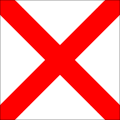









0 Response to "Saltire Games Family & Hobby Game Store Events"
Post a Comment